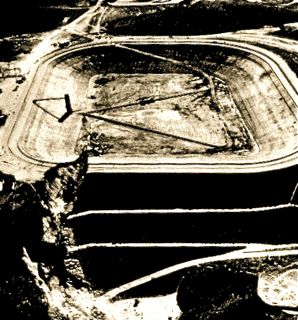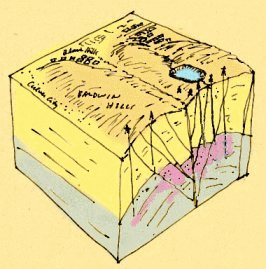Baldwin Hills Dam disaster facts for kids
The Baldwin Hills Dam disaster happened on December 14, 1963. It took place in the Baldwin Hills area of South Los Angeles. The dam holding the Baldwin Hills Reservoir broke, sending a huge flood into nearby homes.
First, there were signs that the dam's lining was failing. Then, water started leaking more and more through the dam. About three hours later, the dam completely broke open. Around 250 million US gallons (946,000 cubic meters) of water rushed out. This disaster caused five deaths and destroyed 277 homes. Many people were saved thanks to quick rescue efforts.
The reservoir was built on a small hill between 1947 and 1951. The Los Angeles Department of Water and Power built it. It was placed directly on an active fault line. This fault was connected to the larger Newport–Inglewood Fault nearby. The ground underneath was not considered stable for a reservoir. So, the design included a special compacted soil lining. This was meant to stop water from leaking into the ground below. Engineers and geologists knew about the fault lines during planning. Some thought they were not a big problem, but others disagreed.
Today, the old reservoir area is part of the Kenneth Hahn State Recreation Area.
Why the Dam Broke
The failure of the Baldwin Hills Reservoir caught the attention of many engineers. It is still studied today. The dam was designed and built after World War II. This was a time when many dams were being built. But some dams were also failing, showing a need for safer methods.
The Los Angeles Department of Water and Power built the dam. They knew the ground conditions were tricky. They also remembered the St. Francis Dam disaster in 1928. That failure killed over 400 people. This showed them how serious a dam break could be, even for a smaller reservoir in a city. Dams were seen as important for progress. But they were also known to be dangerous.
Ralph Proctor was the main engineer for the Baldwin Hills dam. He had also worked on the St. Francis Dam. After that disaster, he developed new ways to build with compacted earth. Proctor moved forward with the Baldwin Hills project. He did this even when others in his department had safety worries or disagreed with his plans.
In 1963, another big disaster happened in Italy. A huge landslide fell into the Vajont Dam reservoir. This created a giant wave that went over the dam. It flooded the valley below and killed about 2000 people. The Baldwin Hills failure happened around the same time.
The Baldwin Hills Reservoir was meant to provide water for Los Angeles. It was a backup in case of earthquakes, fires, or war. Its failure was a big blow to engineering confidence. Many studies and conferences focused on it.
The California Department of Water Resources checked and approved the dam's design and building. In 1964, they published a detailed study. It mentioned connections between oil drilling in the Inglewood Oil Field and ground movement. This included movement under the reservoir. The study vaguely said the failure was due to "an unfortunate combination of physical factors."
Oil Drilling and Ground Movement
The dam's failure led to large money damages. Some investigations after the state study looked for specific reasons. This was to help with legal cases. These investigations focused on the oil drilling nearby.
From the start, people thought the ground faults and slow ground movement that destroyed the reservoir were linked to oil extraction. Over many years, the ground had sunk several feet west of the reservoir. This was due to oil being removed from the Inglewood oil field. The U.S. Geological Survey fully documented this sinking in 1969. Experts in the oil industry had known since the 1920s that removing oil from shallow ground could cause sinking.
In 1970, a geologist named Douglas Hamilton found faulting and oil waste leaking from the ground. This was along the fault that crossed the reservoir. Hamilton and another expert, Meehan, believed that injecting water into the oil field was a major cause of the failure. This was a new technology at the time. They thought it caused cracks in the ground and made the fault move more, even on the day the dam failed.
Later, in 1976, the U.S. Geological Survey agreed. They said that ground shifts that caused the reservoir to fail were mostly due to the Inglewood oil field. They also said that injecting water at high pressures likely made the fault movements worse.
By 1972, nearly ten years after the failure, legal issues were settled. The topic was then discussed openly by experts at a conference.
Engineer Thomas Leps studied the failure. He concluded that the fault under the reservoir had shifted about 7 inches during the dam's life. About 2 inches of this shift happened just months before the failure. Leps linked this to putting pressure back into the oil field. This, along with the ground stretching from about 12 feet of sinking due to oil removal, caused the dam's lining to fail. This led to the dam's destruction.
Some experts, however, believed that oil operations had no major effect. They argued that the dam failed because it was built in a bad location and designed poorly. They thought the heavy weight of the dam and reservoir caused the ground to move. This view supported the oil companies. These experts claimed that ground movements affecting the dam were only found under the reservoir, not in other areas.
These questions were looked at again in 1986. This was after the Teton Dam failed in 1976 and the Lower Van Norman Dam almost failed in the 1971 San Fernando earthquake. Professor Ronald Scott noted that earlier studies had ignored ground movements clearly not related to the reservoir. Another engineer, Stanley Wilson, who had earlier said oil sinking was not a big cause, now agreed. He said that similar ground shifts happened far outside the reservoir area. This meant the dam's failure could not be blamed only on the reservoir itself. So, opinions started to agree that oil field operations played a role.
The idea that oil operations caused the failure was a main topic. Less attention was paid to the details of the dam's failure itself. Most people just assumed the dam needed a lining at this site. This was true even though most earth dams work well without linings. Some ideas for safer dam designs were discussed. These ideas became common knowledge in engineering textbooks by the late 1980s. For example, people suggested using a different material for the dam's lining. The original lining was called clay, but it likely had a lot of silt and sand from the local ground.
In 2001, new research suggested another reason for the failure. Experts Mahunthan and Schofield thought that packing the dam's soil and lining too tightly was a big problem. This idea was based on new theories about soil mechanics. It suggested that very tightly packed soil, if not held down well, could become unstable when water seeped through it. This idea was different from what American engineers usually thought. In fact, the 1964 study had suggested that heavy compaction was a good way to build earth dams. This idea had not been questioned for 25 years after the disaster.
The dam's failure is still studied today in the field of dam-break research. A recent study looked at the dam failure as a two-step process. It successfully modeled how the flood moved through the city below.
The Baldwin Hills Reservoir site is now a community park. There is no longer a risk from ground movements there. However, related faults to the southeast still move. This causes damage to buildings and public areas. The current oil company, Plains Exploration and Production Company (PXP), has increased oil production. Unlike the old company, Standard Oil, PXP does not agree that fault movements are linked to oil activities. They have experts who support this view or say the causes of the movements are unknown.
Recently, a process called hydraulic fracturing (fracking) has been used in the oil field. This involves injecting liquids at high pressure to get more oil. This has caused public concern. Oil companies admit that they use high pressures. But they refuse to say that injecting at these pressures causes fault movement. Other experts disagree with PXP's conclusions.
Recent releases of oil field gases in the Baldwin Hills might also be linked to higher pressures from injection. These gas problems might be similar to those in the nearby Salt Lake field.
News Coverage
KTLA news channel used a helicopter to cover the disaster. This is common today, but it might have been the first time live aerial coverage was used for a breaking news event. Richard N. Levine, a 17-year-old photography student, quickly went to a higher spot. He took many photos of the dam breaking as it happened.



